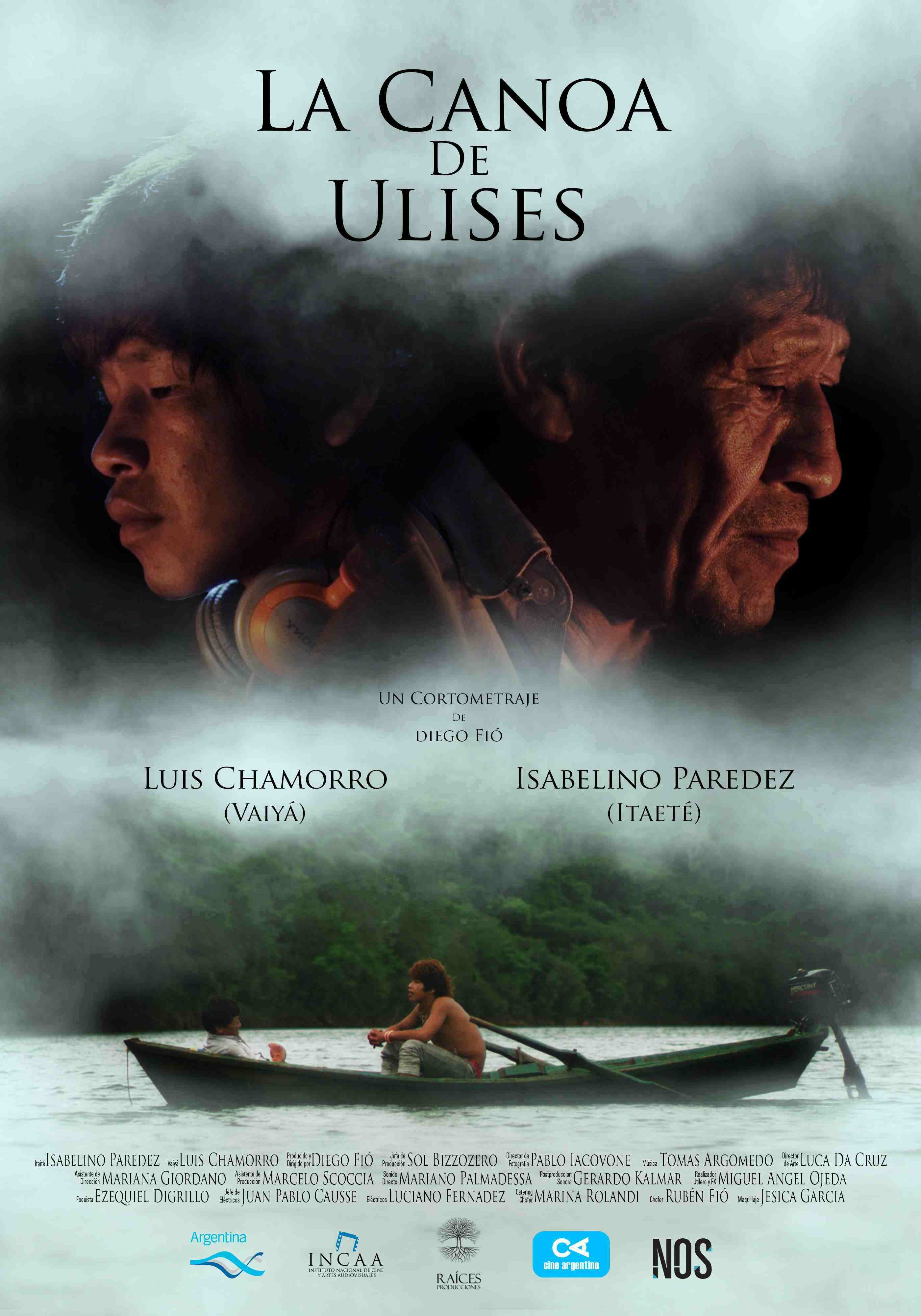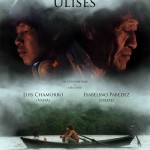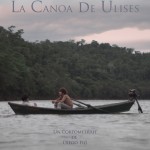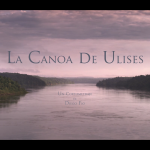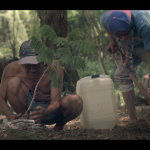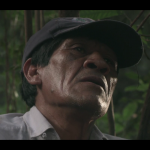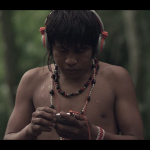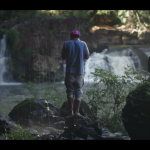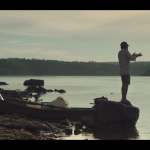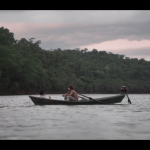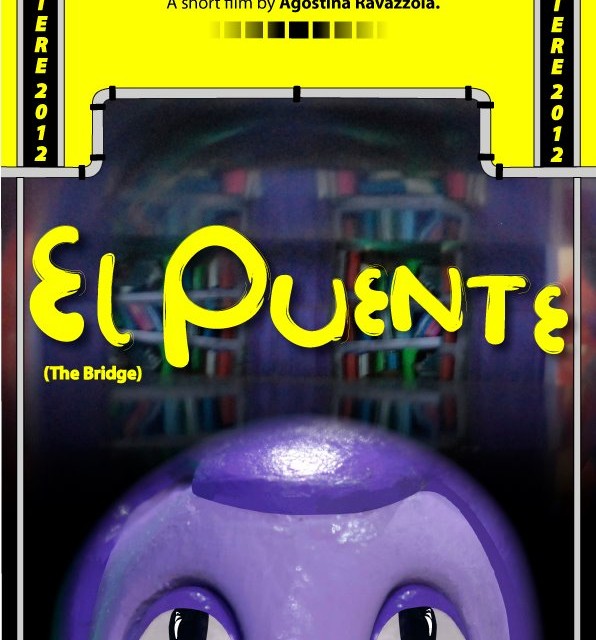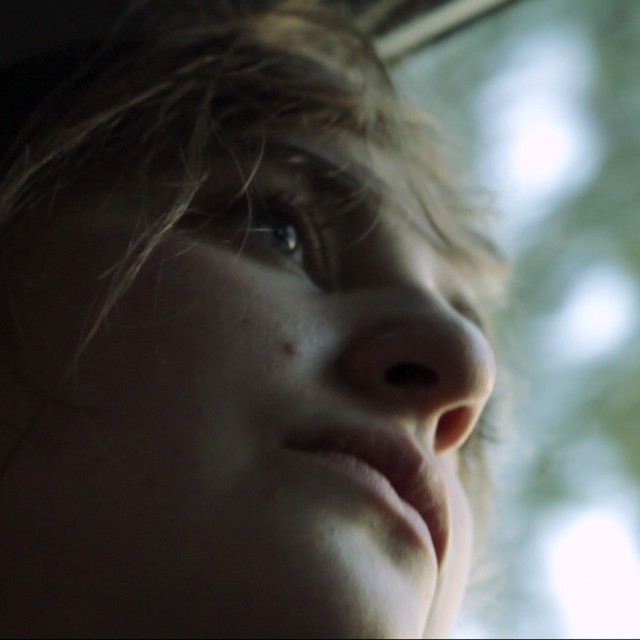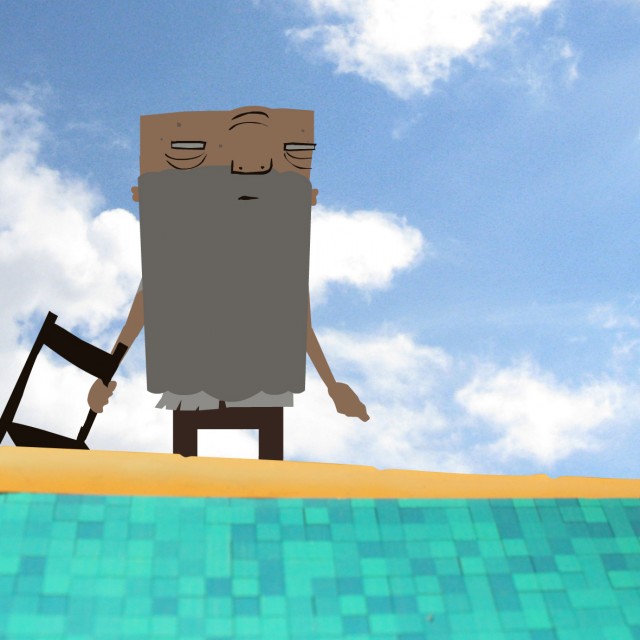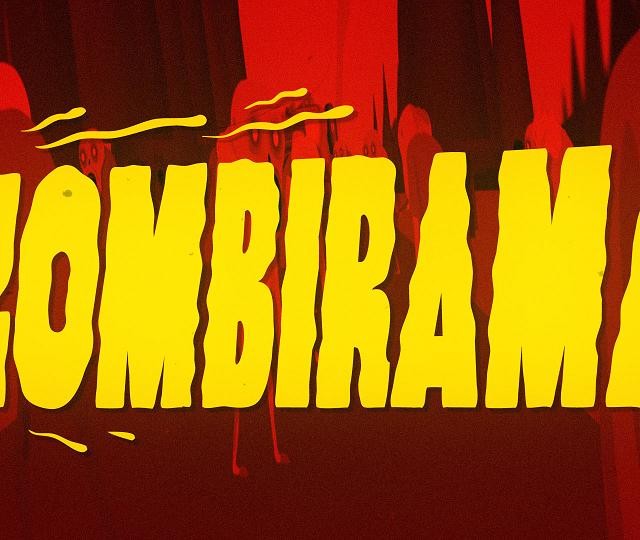Ulise’s Canoe
– Technical Info / Información Técnica:
(2016) / 00:14:19 / HD 1998 x1080 / Red Scarlet / 24 fps / Pal B / Color / Sound: Stereo 5.1 / Argentina
– Synopsis / Sinopsis:
Itaeté and Ulises, a Guraní old man and a guaraní young teenager, are immersed into the jungle, building a canoe. Itaeté is trying instilling a traditional legacy in the boy, but Ulises isn’t very interested. His true calling is music. He’s a rapper.
Itaeté y Ulises, un anciano y un adolescente Guaraní, están internados en el monte construyendo una canoa. Itaeté trata de inculcarle su legado tradicional, pero el muchacho no está interesado. Su verdadera vocación es la música. Ulises es Rapero.
– Long Synopsis / Sinopsis Larga:
Itaeté (old man) and Ulises (15 years old) are immersed deep in de Misionera Jungle, camping. Ther are both Guaraní Indians and are working to turn a timbó tree into a traditional canoe. Itaeté is trying to instil the traditional legacy of canoe construction into the boy, but the boy doesn’t seem to show much interest. His true calling is music. He’s a prapper. Due to a little argument between them, the old man decides to manipulate the tree trunk by himself. It turns out to be too much for him to handle and the tree trunk rolls over the fire and starts to burn. Ulises runs to help him and, together, are able to save the canoe. But, while doing so, a coral snake bites the old man. Ulises doen’t realise this and continues to turn off the fire. The old man goes into the forest in search of a medicinal plant. After healing himself, he prays to his God for assistance. As night comes, Ulises goes to sleep, still mad about the quarrel. The boy ignores Itaeté’s predicament. On the following morning, the old man rises, convalescent. His arm swollen because of the venom. The boy notices the bite and carries him to the motorboat. They start their journey back home, but the old man is in a serious condition. During the journey, the boat runs out of gas and the boy starts rowing. By the time he gets reception on his phone, the old man is dead, but before dying, he has asked the boy to finish the work they had started together. Ulises goes back to the camping, burries the old man close to a young Timbó tree, and goes back to work on the Timbó tree trunk. As he removes the burnt bark with blows from his machete, he uses the beat of his work to start rapping again. His song speaks of Itaeté and the pride of being Guaraní. This time he isn’t rapping in Spanish. This time, Ulises raps in Guaraní.
Itaeté (anciano) y Ulises (15 años) están internados en la Selva Misionera acampando. Ambos son indígenas Guaraníes y están convirtiendo un árbol de timbó en una canoa tradicional. Itaeté trata de inculcarle su legado tradicional en la construcción de canoas, pero el muchacho no está muy interesado. Su verdadera vocación está vinculada a la música. Es rapero. Por una pequeña discusión entre ellos, el anciano decide manipular el tronco solo. Esto hace que la canoa ruede hacia el fuego y comience a incendiarse. Ulises acude en su ayuda y entre los dos impiden que la canoa se destruya, pero, en el descuido, una serpiente de coral muerde al anciano. Ulises no percibe esto y continúa trabajando para apagar el incendio. El anciano se interna en el monte buscando una planta medicinal. Luego de hacerse una curación, reza a su Dios para que lo ayude. Ya de noche, Ulises se duerme aún ofendido por aquel pleito. El muchacho desconoce el padecimiento de Itaeté. A la mañana siguiente, el anciano se levanta convaleciente. Tiene el brazo hinchado por el veneno. El muchacho nota la picadura y lo carga en sus hombros. Ambos emprenden el retorno en el bote a motor que los trajo, pero Itaeté se encuentra muy grave. En el viaje, el bote se queda sin combustible y Ulises tiene que continuar remando. Para cuando el muchacho consigue tener señal de celular, el anciano ha muerto, no sin antes pedirle que termine la canoa. Ulises vuelve al campamento, entierra al anciano cerca de un pequeño árbol de Timbó y retoma su trabajo con la canoa. Mientras golpea con el machete la corteza quemada de la canoa, rapea utilizando los golpes como Bits. Su rap habla de Itaeté y del orgullo de ser guaraní. Esta vez el rap no es en castellano. Esta vez Ulises rapea en Guaraní.
– Director´s Biography / Biografía del Director:
DIEGO FIÓ
Musician, photographer and nature lover, Diego Fió was born October 30, 1978 in Buenos Aires, Argentina. Having completed his studies at Buenos Aires University, he began his career as an assistant director in advertising cinema. Working for 7 years with the best directors, Diego filmed in Brazil, Uruguay, Colombia, Spain, The Netherlands and Switzerland. Interested in developing his own career as a director, Diego Fió filmed commercials and documentaries, but fiction hit him in the missionary jungle of Argentina. There he met the character that inspired his first short film: Ulises Canoe.
Músico, fotógrafo y amante de la naturaleza, Diego Fió nació el 30 de octubre de 1978 en Buenos Aires, Argentina. Habiendo cursado imagen y sonido en la Universidad de Buenos aires, comenzó su carrera profesional como asistente de dirección en cine publicitario. Trabajo durante 7 años con los mejores directores de Argentina y así filmó en Brazil, Uruguay, Colombia, España, Holanda y Suiza. Interesado en desarrollar su propia carrera como Director, Diego Fió filmó comerciales y documentales, pero la ficción lo alcanzó en la selva misionera de Argentina. Ahí conoció al personaje que inspiró su primer cortometraje: La Canoa de Ulises.
– Director’s Statement / Declaraciones del Director:
The word tradition fascinated me since childhood. According to the dictionary, is the culture of a determined community, maintained and transmitted from generation to generation. My grandparents respected their tradition as the anchor that held them from drift. When I was young I thought that this word was loaded with a conservative and rigid connotation, as something to be kept to the letter, without justification, static and unchanging. But as I grew older, I invisibly incorporated those traditions. This time with my own imprint. I was creating my own traditions with my contents but also with contents of my ancestors. This became crucial to discover my real and genuine «me». This revelation, which for many can be evident, was so surprising that led me to the creation of this film. Traditions, far from being rigid, are permanently changing. Each generation chooses what he wants to endure and adds it to its own history, to his own habits. The Word tradition is nearer to the word change than to the word permanence.
Since occidental conquerors displaced the original people of the Americas, the indigenous has tried to adapt to the new territorial and cultural reality. The reduction of its territory, to an insignificant piece, made the indigenous change his lifestyle very much linked to nature, to enter the ranks of the capitalist system imposed by Western culture. This isn´t todays new and has been happening since Cristobal Colon put a feet in The Americas, but today, with the advance of technology, the connectivity and the massive media, the indigenous access to global content and tries to decode and incorporate them into their own culture.
This film was born from a trip in which I met a group of Guaraní teens that make Hip Hop music. (Guarani is an indigenous group of northern Argentina, Southern Brazil and Eastern Paraguay). At the beginning they started making the lyrics in Spanish but as the interest grew in the different Guaraní communities, they started using their native language. The Guaraní.
They use Hip Hop because RAP allows them to easily express the injustice and the abuse that their people are submitted. Today, this young Guaraní group is not making old traditional music; instead they are creating their own tradition doing Hip Hop to tell the world their truth. I was being a privileged witness of the creation of a new tradition. The elders trying to understand this new music and teens looking to distinguish and evaluate witch part of the ancestral culture keep. Those worlds were so different that the clash of the new and the old tradition was very powerful.
The canoe is that symbol. It is that element that once was crucial in the life of this people and today is meaningless and has no functionality at all. Today´s boats are made industrially and it has no sense to make them the traditional way. But the art of building canoes with Timbó trees is what connects the Guaraní people to their ancestors, their beliefs and their history. As the anchor that holds them from drift.
That’s what this film is about. The clash of the old and the modern, tradition versus innovation, but above all, discovering our own identity, discovering ourselves. A tree becomes a tree only when its root hugs the ground.
La palabra tradición me fascinó desde niño. Según el diccionario, es el conjunto de bienes culturales que se transmiten y se mantienen de generación en generación dentro de una comunidad. Mis abuelos las tenían y las cumplían como el ancla que los sujetaba de la deriva. En mi niñez creí que esa palabra estaba cargada de una connotación conservadora y rígida. Como algo que debía mantenerse a rajatabla, sin justificación, estática e inmutable. Pero a medida que iba creciendo, iba incorporándolas invisiblemente. Esta vez con mi propia impronta. Fui creando mis propias tradiciones con contenidos míos pero también con contenidos de mis antepasados, y así fui descubriendo mi “yo” más genuino y real. Esta revelación, que para muchos puede ser evidente, para mí fue tan sorprendente que dio lugar a la creación de este cortometraje.
Las tradiciones lejos de ser rígidas, cambian permanentemente. Cada generación elige lo que quiere hacer perdurar y lo suma a su propia historia, a sus propios hábitos que surgen de la edad histórica que es toca vivir. La palabra tradición está más cerca de la palabra cambio que de la palabra permanencia.
Desde que los pueblos originarios de América fueron desplazados de sus tierras a manos de los conquistadores, el indígena ha tratado de adaptarse a la nueva realidad tanto territorial como cultural. La reducción de su territorio a la mínima expresión llevo al indígena a cambiar su modo de sustento, vinculado a la naturaleza, para colocarlo en las filas del sistema capitalista impuesto por occidente.
Esto no es nada nuevo y viene sucediendo desde que Colón puso su pié en América, pero hoy en día, con la conectividad que nos permite internet y los medios de comunicación modernos, el indígena accede a contenidos globales y trata de decodificarlos e incorporarlos a su propia cultura.
Este cortometraje nace de un viaje en el que conocí un grupo adolecentes Guaraní-Mbya que hacían Hip Hop. (Guaraní-Mbya es un pueblo indígena del norte de Argentina). Ellos utilizaban ese género musical porque podía expresar fácilmente su contenido de protesta ante la injusticia que el indígena tiene que soportar diariamente. Ya no se hacían canciones tradicionales Guaraníes sino que se utilizaba el RAP y el Hip Hop para decir lo que necesitaban que el mundo escuchase. En un principio hacían canciones en español, pero a medida que las diferentes comunidades guaraníes, esparcidas por la selva misionera, se iban interesando en ellos, los adolescentes decidieron comenzar a rimar y componer RAP y HIP HOP en su lengua nativa. El Guaraní-Mbya.
Sin darme cuenta estaba siendo testigo de la creación de una nueva tradición, pero siendo los mundos tan diferentes, el choque de lo antiguo y lo moderno era muy potente. Los ancianos tratando de entender lo nuevo y los adolescentes buscando distinguir y valorar lo ancestral. Eso tan antiguo que pierde la lógica en mundo de hoy. La canoa es ese símbolo. Es ese elemento que fue fundamental en la vida de este pueblo y que hoy carece de sentido y funcionalidad. Sin embargo el arte de la construcción de canoas con árboles de timbó es lo que arraiga al Guaraní a sus ancestros, a sus creencias y a su historia. Tanto como un ancla que los sujeta de la deriva histórica.
De eso trata este cortometraje. Del choque de lo antiguo y lo moderno, de la tradición frente a la innovación, pero sobre todas las cosas trata del descubrimiento de la propia identidad, del descubrimiento de nosotros mismos. El árbol es árbol solo cuando sus raíces abrazan el suelo.
– Overview / Ficha técnica:
Script / Guión: Diego Fió
Producer / Producción: Diego Fió
Production Manager / Jefe de Producción: Sol Bizzozero
Producer Assistant / Asistente de Producción: Marcelo Scoccia
Director / Director: Diego Fió
Director Assistant / Asistente de Dirección: Mariana Giordano
Art Director / Director de Arte: Luca Da Cruz
Cinematography / Dirección de Fotografía: Pablo Iacovone
Camera / Cámara: Pablo Iacovone
Editing / Edición: Diego Fió, Andrés Quaranta
Music / Música: Tomás Argomedo
Direct Sound / Sonido directo: Mariano Palmadessa
Sound Design: Gerardo Kalmar
Cast / Elenco: Isabelino Paredez, Juan Luis Chamorro
– Festivals and Awards / Festivales, Premios y Nominaciones:
– BAFICI; 04/2016; Argentina
– Huesca International Film Festival; 06/2016; España
– Festival de Cortometrajes “Semana de Soria en Buenos Aires” – “Special Mention”; 08/2016; Argentina
– MARFICI, Festival Internacional de Cine Independiente de Mar del Plata; 08/2016; Argentina
– Curta Kinoforum, Festival Internacional de Curtas Metragens de Sao Paulo; 08/2016; Brasil
– FLVR, Festival de Cine Latinoamericano de Rosario; 09/2016; Argentina
– Festival Biarritz Amérique Latine; 09/2016; Francia
– Festival Internacional de Cine de Ponferrada; 09/2016; España
– Festival Internacional de Cine del Paraguay; 10/2016; Paraguay
– Pizza, Birra y Cortos, Festival Nacional de Cortometrajes – “Best Short Film”; 10/2016; Argentina
– Tres Fronteras, Festival Internacional de Cine – “Best Short: Local Competition”; 10/2016; Argentina
– Festival Internacional del Nuevo Cine Latinoamericano de la Habana; 12/2016; Cuba
– FECIMA, Festival de Cine del Barrio Mapocho; 12/2016; Chile
– Clermont Ferrand International Short Film Festival; 02/2017; Francia
– Hacelo Corto, Festival Internacional – “Best Cinematography”; 03/2017; Argentina
– Penca, Short Film Festival – “Best Short: RAFMA Award”; 03/2017; Argentina
– Festival Cordillera – Best Short Film; 04/2017; Ecuador
– CMS International Children’s Film Festival; 04/2017; India
– BioBioCine, Festival Internacional de Cine en Concepción; 04/2017; Chile
– UNCIPAR, Jornadas Internacionales de Cine y Video Independiente – “SAGAI Award: Best Male Performance” “ACCA Award: Best Short film”; 04/2017; Argentina
– EPA CINE, Festival Internacional De Cine De El Palomar; 05/2017; Argentina
– Kurumin Cine – Festival Internacional de Cine Indígena; 07/2017; Brasil
– Encontro de Culturas Tradicionais da Chapada dos Veadeiros; 07/2017; Brasil
– Molise Cinema Film Festival; 08/2017; Italy
– FIFNL, Festival International du Film de Nancy; 08/2017; France
– FESAALP, Festival de cine Latinoamericano de La Plata; 09/2017; Argentina
– FILMETS, Badalona Film Festival; 10/2017; Spain
– Cote Bleue, Festival International de Courts Metrages; 10/2017; France
– Mirada Oeste, National Film festival – “Best Narrative Short: Press Award”, “Best Narrative Short”, “Argentores Award: Best Narrative screenplay”; 10/2017; Argentina
– Paris Courts Devant, International Short Film Festival; 11/2017; France
– ZUBROFFKA, International Short Film Festival; 12/2017; Polonia
– See You Sound, International Music Film Festival; 01/2018; Italy
– Dresden International Short Film Festival; 04/2018; Germany
– 66 Nominación al Premio Condor de Plata; 08/2018; Argentina
– 12 Muestra Cine + Video Indígena, MUCIVI; 08/2018; Chile
– 10 Imágenes Sociales, Festival Latinoamericano de Cortometrajes – Best narrative Short film; 10/2018; Argentina
– 11 Festival Internacional de Cine y Video Alternativo y Comunitario Ojo al Sancocho; 10/2018; Colombia
– 14 Cine Vivo, Perth Independent Latino Film Festival; 10/2018; Australia
– 13 Arica Nativa, Festival De Películas Nativas; 11/2018; Chile
– 3 Strano Film Festival; 08/2019; Italy
– 37 Sulmona IFF; 11/2019; Italy
– Links:
Facebook: https://www.facebook.com/La-Canoa-De-Ulises-743737985758188/


